Core-spun yarns have a central core that is wrapped with staple fibres, and are produced in a single operation at the time of spinning. For example, a cotton sheath for handle and comfort, with a filament (often polyester) core for added strength; or cotton over an elastomeric core. Core-spinning is a process in which the fibers are twisted around an existing yarn either in the form of a filament or the staple spun yarn. This process is taken up for the production of the core structure of sheath from the already formed core of the yarn. The core-spun yarns are the two-component structure of the core and the sheath. In a general scenario, the filament of the yarn is used as the core, and the staple fibers are used for the covering of sheath. The core-spun yarns are used for the enhancement of the functional properties of the fabrics like the stretch, durability and the strength, which together end up as the comfort of the fabric.
Method of production of core spun yarn– Spinning yarn is popularly used to make the textile threads for sewing. The sewing threads are used for many textile projects and upholstery projects of home. The spun yarn and the synthetic yarns are weaved because they are much stronger. The twisting of the threads made out from this yarn is extremely convenient. The methods of the Core-Spun Yarns are named below.
- Conventional core spinning in the ring frame
- core wrap spinning
- composite electrostatic system of spinning
- system of air jet spinning
- patterned spinning system
- core twin system of spinning
- spinning by system of friction
1) Conventional core spinning in the ring frame– A core spinning attachment in ring spinning is shiwn in figure. The attachment consists of metal plate (Bracket) bent to a shape. One end of the device is fitted on the roving traverse guide bar such that the relative position of the roving and the core filament may be kept constant all the time. There is a provision to vary the position of the device if required. The other end of the plate is fitted with a porcelain guide that feed the core filament at a precise position behind the front drafting rollers. This devise is fitted with a pre-tensioner and is kept in a horizontal plane. Varying the number of tension discs may vary the input tension of the core filament. The package containing core filament material is suspended from a bar such that they could rotate easily, thus avoiding any tendency to stretch the filament before it is fed to the tensioning device.
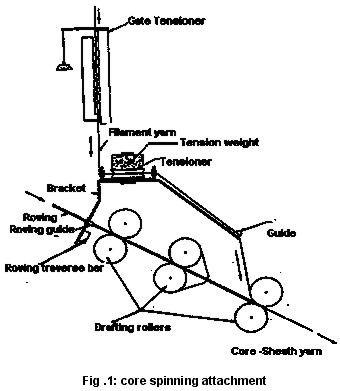
2) Core wrap spinning– In conventional core-spinning system yarns are merely a ply twisted and does not have good core coverage, strip back problem may arise during subsequent mechanical processing. The core wrap yarns produced by the SRRC core spinning system consists of a central core of a particular filament or staple fiber and core material is almost coaxially and totally wrapped with cotton on any other staple fiber. It is claimed that a high degree of coherence is obtained between the constituent fibers. The core-wrap assembly is used as twist breaker, which helps the sheath fibres to cover the filament.
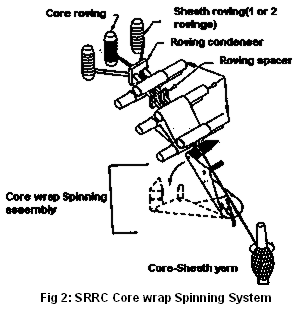
3) Composite electrostatic system of spinning– Smith & others [3] developed a method for producing with the mixed construction of staple and filament fibers involved with use of the frictional contact methods by using electro static system and short comings with this system was only hydrophobic fibers can be handled, and often filaments tend to break and wound around the rotating components. This system prone to safety problems because of the high voltage required and a water supply required for imparting the electrical conductivity to the continuous filament yarn.Another electrostatic filament charging method shown in the figure uses two electrodes to separate the multifilament yarn. The filament charging device is described which is based on the principle of two electrodes system; this was employed to separate a multi filament yarn. The separated filaments were then mixed with the staple fibers of roving at the roller nip on the ring spinning system as illustrated in the figure. The blended ribbon was subsequently twisted to form a yarn. This is an effective measure for resolving the strip back problem.
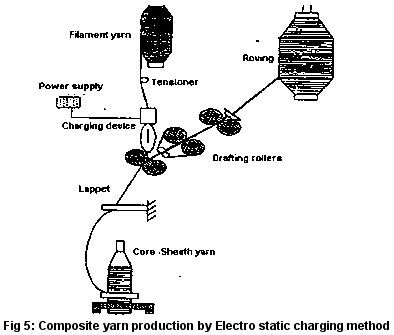
4) System of air-jet spinning-It was reported that the Air-jet spinning could be used for producing core yarns after optimizing process parameters. A relatively higher first nozzle pressure is advantageous for improving sheath-slippage resistance. The use of higher spinning speed and wider condenser markedly improves the tenacity, breaking extension, initial modulus and sheath-slippage resistance and affects the yarn hairiness, mass irregularity and flexural rigidity. However, yarn properties deteriorate at high spinning speed especially for finer yarns.
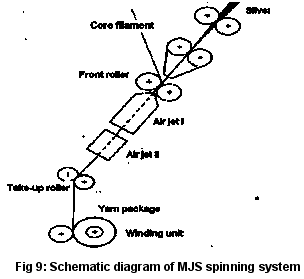
6) Core twin spun yarn– The figure is a schematic illusion for the core twin spin yarns. In the spun silk ring spinning frame the drafting part was equipped with an apron device for cotton fibers, because they were shorter then the silk fibers. The continuous filament core-spun yarn passes through a control disc inserted directly behind the front roller in a drafted strand of either cotton or spun silk via a core yarn guide. The drafted spun silk and cotton strands and the scoured silk continuous filament core yarns were twisted together as they emerge from the front rollers.Usually the core yarn guide remains at a fixed position and also possible to move them by moving the position rollers. When the rollers change the position of the guide, the core yarns migrate periodically from the spun silk to cotton and from cotton to spun silk. When scoured silk core yarn is inserted in the spun silk strand only, this yarn was called silk sided core twin spun yarn; when the core yarn is inserted in the cotton strand only, this yarn is called cotton-sided core twin spun yarn; when the core yarn inserted periodically in the both strands, this yarn is called migrated core twin spun yarn.
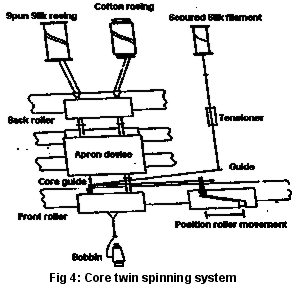
Effect of process variable in ring core spun yarn–
- Core sheath ratio
- pre-tension applied to the core material
- Spinning draft
- Number of roving feed
- Twist
Core sheath ratio-It has been found that decreasing sheath content will increase the strength of the core-spun yarn. Apart from this there is an improvement in the extension and the evenness properties. In the case of core-spun sewing threads, a 2: 1 ratio of core sheath gives poor core coverage, and may raise problem of stripping off the sheath during the sewing, whereas, with a 1:1 core sheath ratio the striping off problem reported to minimize.
Pre-tension applied to the core material-The pre tension is needed to regulate the geometrical position of the filament. This input tension varies with the twist factor, size and the quality of the filaments used. Balasubramaniam furnished a method for optimizing the tension of the core filament in the core spinning process. Colored filament was passed over a tension device of attachment and fed before the nip of the front roller of the ring frame. The pre tension was gradually raised until the colored filament is completely covered by the cotton fibres, and this value was taken as the optimum input tension. It was approximately 10% of the breaking load of the core yarn. An introduction of a compensatory tensioner can be reducing the tension variation . An extension of 1 % to the core filaments while feeding to the ring frame ensures no buckling or curling of sheath fibres. Core yarns are usually pre- tensioned to an extension of around 5-10% for flat continuous filaments yarns, about 30% for textured yarns and up to 400% for an electrometric core. If insufficiently tensioned, the filament will either periodically appear at the yarn surface, grin through or become wrapped around the fibre ribbon as the ribbon being twisted .
Spinning draft-Spinning drafts can be varied to obtain the required yarn count based on the core the sheath ratio.
No. of roving feed-The possible ways of feeding the core material at the front roller nip with respect to roving are:
- Filament at the center of the roving
- Filament at the sides of the roving
- Filament on the top of the roving.
Two-rove feeding (Filament at the center of the rovings ) provides better core positioning and control during spinning influences the structure and properties of core-spun yarns .
Twist-Adequate cohesion obtained in individual yarns at high twist rates and it is minimize the sheath slippage .In addition to this, the filament pre-twist in opposite direction to the ring twist reduce the sheath slippage .The extension of the core-spun yarn tends to reduce at higher twist levels.
7) Spinning by system of friction– In friction spinning system the fibres are individually collected and twisted to form yarn. A wide range of staple length can be processed by this system. In Dref II system, the deposition and the twist of fibres on to the yarntail is to be replaced by a filament core to obtain full coverage of core. Dref-III (Wrap spinning system) is a frictional spinning process; a drafted ribbon of parallel fibres that constitute the bulk of the spun yarn is wrapped by either surface fibres protruding from the ribbon or by continuous filaments so as to impart coherence and strength to the resulting yarn.It is believed that the core is false twisted by the rotation of the friction drums before being wrapped by the sheath fibres. Strength of the Dref III core-spun yarns have direct relationship with the strength of core filaments and number of sheath fibres that are active in generating radial pressure due to their structural helical configurations. The effectiveness of wrapping of sheath fibres depends on physical and mechanical characteristics of fibres, configuration, length variations, firmness of the wrap and wrap angle.
Application– There are countless applications of the core-spinning yarn, and as threads, they can be used in quilts, mattresses, leather products such as ladies handbags, shoes, etc. Due to their immense durability and strength, they are widely used in rice bags too.
Advantage of core spun yarn– Development of core-spun yarn with ring spinning system unveils path for new products including high performance textiles, sewing threads and in the garmenting areas due to its exceptional strength, outstanding abrasion resistance, consistence performance sewing machine, elasticity for the stretch requirements, excellent resistance in perspiration, ideal wash and wear performance and permanent press.
